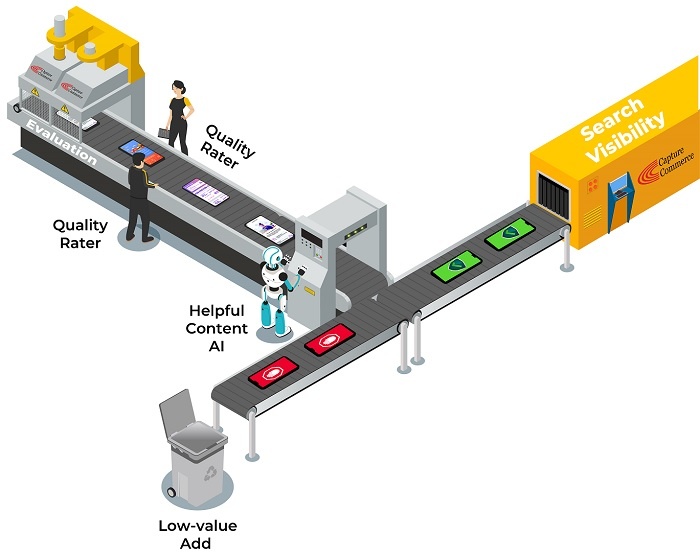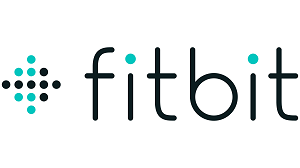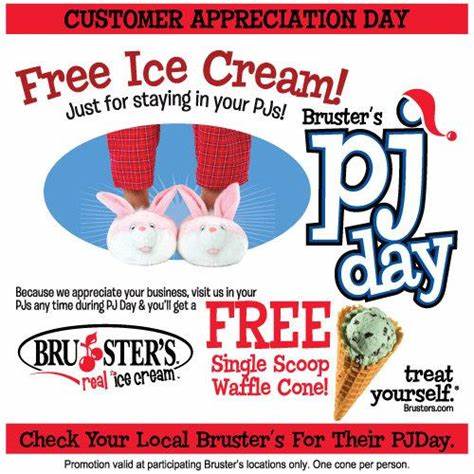Building trust with prospects is a normal part of a good sales person’s job; shouldn’t it be normal for marketers as well?
Regardless of how a prospect found your biz, positive results depend on qualified prospects who are in the process of making a buy decision.
Take Otis, for example, Otis is an entrepreneur whose ecommerce business is faced with a marketing challenge.

Otis is a skeptical, slow-paced decision maker, so when he lands on a marketing services site with a high level of motivation to solve his problem, he will notice even minor details about the site. He’s there to check things out on a number of levels.
Site elements move from being unnoticed to noticed because Otis is motivated and involved.
What will Otis think if he notices a couple of errors, or if he cannot find real people or an organization behind the site, or if offers and videos keep interrupting him while reading a post?
“Hmm, that’s concerning.”
Google describes the helpful content update (HCU):
The helpful content system aims to better reward content where visitors feel they’ve had a satisfying experience, while content that doesn’t meet a visitor’s expectations won’t perform as well.
Google uses machine learning in the HCU; it’s how Google teaches computers to do something, often with better accuracy than a person.
It involves supervision, where data containing the “right answers” is used to create algorithmic models.
Human quality raters help train the HCU so it can identify content that has little value or is not helpful to people.

Google’s rule for over a decade has been consistent: create content for people, not search engines.
Easy right?
Google is, has and will always be at war with content that doesn’t help people much.
[Quick background] Quality content was the thrust of these Google algorithms:
- Panda (2011)
- Penguin (2012)
- Hummingbird (2013)
- RankBrain (2015)
- Bert (2019)
- The Helpful Content Update (2022)
I suspect the HCU was a response to AI content that people didn’t want. (Not that AI content isn’t valuable, some is.)
Google’s HCU lowered sites with content that did not focus on user experience and value.
Checklist for content creators who want Google’s favor:
- Is my focus on keywords or selling more important than the problems and interests of the prospect?
- Does my adherence to standards and best practices interfere with me creating a personal and emotional connection with the prospect?
- Has the quantity of content taken precedence over its quality or depth?
- Am I appealing to a broader audience to get as much traffic as possible rather than appealing to a niche?
If you suspect your site suffers from the HCU or isn’t as people-first as it could be, here are a few things you can do.
- Do a sitewide content evaluation and improve those that are not helpful or remove them. You can assess the quality of your content and create people-first content with this guide from Google.
- Review Google’s definition of E-E-A-T; trustworthiness (T) is the most important of these.
- If time permits, review the latest Search Quality Rater Guidelines.
- Marie Haynes provides a good analysis of the HCU along with recovery tips here.
How does the HCU impact SEO and content strategy?
First, sites that over optimize for ranking purposes have and will continue to lose. I’ve seen cases this year where removing over optimization from a site resulted in lift.
Some think making a few changes to a particular piece of content will fix the problem.
No, it won’t because this is a site wide update. Google has discovered many pieces of content that tells them “For ranking” over people.
Honestly, HCU reminds me of Panda.
Google’s goal with Panda was to improve search results by filtering out low quality sites (eerily like HCU).
When Panda hit, it felt like an earthquake that leveled most of the buildings – many businesses went under. It was an industry changing event!

I can guarantee you SEOs and content creators who survived Panda were not affected by HCU.
When Panda rolled out, I was already producing content that I thought to be good quality. I can’t really say I changed my content that much based on the famous 23 questions Google released after Panda. But, losing my best site and business to Panda made me gradually raise the quality of content I produced.
Emory Rowland, Leverable
SEOs and content creators who are battle scarred from past Google updates tend to be very effective at engaging ideal prospects.
Marketers are learning how to use AI (that’s good), but some went too far and tripped a Google update (not good).
Many are still not sure what “helpful content” means or how to use AI in content creation.
This Think with Google resource is insightful: How consumer needs shape search behavior and drive intent.
When people search on Google, their behavior is influenced by six canonical consumer needs:
- Surprise Me: Seeking entertaining and novel content.
- Help Me: Looking for practical assistance and solutions.
- Reassure Me: Wanting comfort, trust, and confirmation.
- Educate Me: Searching for information and understanding.
- Impress Me: Desire for status, importance, and to impress others.
- Thrill Me: Looking for excitement and adventure.
These needs impact how people search, such as the length of queries, the number of searches performed, and the type of content (text, image, video) they prefer.
How can you tap into one of these 6 consumer needs and show your solution?
Content based on E-E-A-T is great if you have access to a source because it can satisfy those who want experience, expertise and authority (the E-E-A in E-E-A-T), like Otis.
But, if you don’t have access to that type of source, tap into the other four consumer needs by creating content that builds trust with prospects.
Trustworthiness is the T in E-E-A-T, it is most important and critical to marketing.
E-E-A-T is really all about trust:
- Experience (E) leads to trust (T)
- Expertise (E) leads to trust (T)
- An authoritative (A) source leads to trust (T)
And trustworthiness can be communicated in a thousand different ways, not just with E-E-A.
A trustworthy source is not as easy to find today, and consumers are skeptical about sources and have a sophisticated, built-in, “BS detector.”
Here are a few examples of communicating trust, without E-E-A. (AI by ChatGPT helped find some of these.)
Give your prospect a “free lunch”

In 2009 MailChimp launched its freemium model. They used their pricing data to offer a free version of their service without impacting their existing paid plans. This strategy included branding emails sent by free users with a MailChimp badge, creating a viral marketing effect. As a result, within a year, their user base grew fivefold, and profits surged by 650%!

Canva’s freemium model offered a tiered approach: free, pro, and enterprise plans. They allowed anyone to design without an account, which boosted user acquisition. They included a free trial for pro and enterprise plans to showcase the value of premium features, encouraging upgrades from free to paid plans.
Learn about Canva’s freemium model.
Influencer partnerships – give influencers everything they need to vouch for you

HelloFresh’s influencer marketing strategy played a significant role in its growth. They enlisted influencers like Mandy Moore, Taylor J Philippe, and Audrina Patridge to showcase their meal kits. Influencers used hashtags such as #freshfriends and #hellofreshpics, which helped to personalize and amplify the reach of their campaigns.
Learn about HelloFresh’s marketing strategy.
Entertainment and PR Stunts
The Blendtec “Will It Blend?” YouTube campaign was a serendipitous creation that began with a bit of fun. George Wright, the marketing manager, was inspired by Tom Dickson (Blendtec’s founder) using blenders to turn 2x4s into sawdust to test their power and durability. Wright proposed filming Dickson blending various items. The episodes evolved to include jokes and gags, like the recurring line “Don’t breathe this.”
Learn the story behind Will It Blend?
Community Building

Fitbit (seller of wearable fitness trackers) created a platform where users could track their progress, challenge friends, and share achievements. This sense of community and shared goals around fitness encouraged users to buy Fitbits to participate in the community, which in turn helped to drive sales and brand loyalty.
Learn about Fitbit’s community building.
Marketing promo

Bruster’s PJ Day – to kick off the spring ice cream season, anyone who visits their favorite Bruster’s location wearing pajamas on the designated day will receive a free small waffle cone in any available flavor.
Excellent user experience

Stripe’s growth was influenced by its focus on providing an exceptional user experience.
The company was born out of frustration with the complexities of online payment systems. Stripe allowed developers to integrate payment processing with just a few lines of code. The norm had been the cumbersome setup of payment gateways, credit card storage, PCI compliance and bank management.
This led to rapid word-of-mouth promotion within the developer community, making user experience a key marketing strategy.
Even very skeptical prospects, like Otis, will use some of these gems to learn if a marketing provider can solve his challenge.
Robert Stephens, Founder of The Geek Squad, explained his approach to marketing like this…
Marketing is a tax you pay for being unremarkable. We had to stand out because we had no money for advertising. Make a name for yourself and build that base.
Robert Stephens
To sum up, today’s marketers do well by:
- Helping skeptical prospects by building trust.
- Not allowing guidelines or best practices to interfere with creating an emotional connection with prospects.
- Managing a prospect’s built-in BS detector advantageously.
- Creating resources that attract prospects and inspire customers to be brand advocates.
Hmm, should marketers be as good at building trust with prospects as sales people are?
Word! Bet! Right on the money!
2 replies to "Building Trust: the key to helping skeptical prospects"
“Marketing is a tax you pay for being unremarkable. We had to stand out because we had no money for advertising. Make a name for yourself and build that base.”
Love this quote. I believe I heard Elon Musk say that Tesla doesn’t buy advertising.
Yep, the WOM effect can happen with a little creativity and a bit of trial and error.